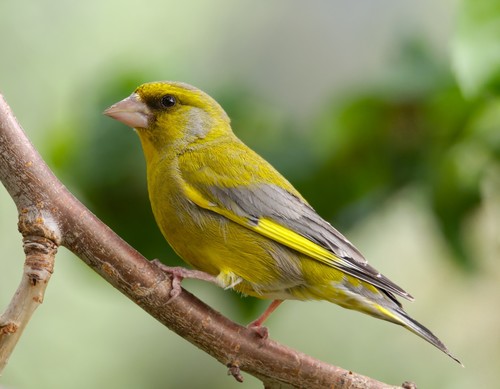
European Greenfinch
The European Greenfinch (*Chloris chloris*) is a vibrant and familiar bird commonly found across Europe and parts of North Africa and the Middle East. Known for its bright olive-green and yellow plumage, it plays a vital role in seed dispersal within its ecosystem. It's a frequent visitor to gardens and parks, often seen at bird feeders. While not holding specific major cultural significance, its cheerful song and lively presence have made it a welcome sight for birdwatchers and nature enthusiasts for generations. Its adaptability has allowed it to thrive in various habitats, though recent population declines raise concerns.
14-16 cm
Length
24-27 cm
Wingspan
Least Concern
Conservation Status
Distribution
The European Greenfinch is native to Europe, North Africa, and Southwest Asia. Its range extends from Scandinavia in the north to the Mediterranean region in the south, and from Ireland in the west to parts of Russia and the Middle East. It has also been introduced to other regions, including South America and New Zealand. They are generally resident, but some northern populations may migrate south for the winter.
Lifespan
Typically 2-3 years in the wild, though some individuals can live longer (up to 13 years recorded in captivity).
European Greenfinch's Habitat
Habitat Types
Woodlands, Farmlands, Gardens, Parks, Hedgerows, Orchards
Climate Zones
Temperate, Mediterranean
Adaptations
The Greenfinch's robust bill is well-suited for cracking seeds, a primary food source. Its relatively short wings allow for maneuverability in dense vegetation. They have adapted well to human-altered landscapes, thriving in areas with sufficient food and nesting sites.
Variations
Several subspecies of the European Greenfinch are recognized, differing slightly in plumage coloration and size. These variations are often subtle and linked to geographic location, such as island populations or those at the edges of the species' range.
Appearance
Breeding Plumage
Males in breeding plumage are brighter, with more intense yellow and green coloration. Non-breeding males and females are duller, with more brownish tones.
Seasonal Feather Changes
Plumage becomes brighter in spring for the breeding season and duller in autumn and winter.
Sex Based Plumage Differences
Males are generally brighter green and yellow, particularly on the wings and tail. Females are duller, with more brown and less vibrant yellow.
Notable Features
Bright yellow wing bars, Yellow edges on the tail feathers, Thick, conical bill, Olive-green body (especially in males)
Diet and Feeding
Primary Foods
Seeds, Berries, Buds, Insects (especially during breeding season)
Foraging Behavior
Greenfinches often forage on the ground, in bushes, and in trees. They are frequently seen at bird feeders, particularly those offering sunflower seeds or peanuts. They use their strong bills to crack open seeds.
Specializations
Their strong, conical bill is a specialized adaptation for efficiently cracking open a wide variety of seeds.
Seasonal Diet Variations
During the breeding season, they consume more insects to provide protein for their growing chicks. In winter, they rely more heavily on seeds and berries.
Behavior
Social Structure
Greenfinches are often seen in small flocks, especially outside the breeding season. During breeding, they may be more territorial.
Communication
Variety of calls, including a distinctive 'dzweee' call, Song consisting of a series of trills and twitters, Visual displays, such as wing flicking
Migration
While many populations are resident, some northern populations migrate south for the winter. The extent of migration varies depending on the severity of the winter.
Territorial or Group Behaviors
During the breeding season, males defend territories around the nest site. Outside of breeding, they are more gregarious and form flocks.
Conservation
Threats
Habitat loss (due to agricultural intensification and urbanization), Disease (Trichomonosis, a parasitic disease, has caused significant declines), Pesticide use (reducing insect prey and potentially poisoning birds), Climate change (affecting food availability and breeding success)
Protection Programs
Monitoring programs to track population trends, Research into disease management, Promotion of agri-environment schemes to improve habitat
Local National Laws
Protected under various national and international wildlife laws, such as the EU Birds Directive.
Population Trend
Decreasing in some regions, particularly in the UK, due to disease outbreaks. Globally, the population is considered relatively stable.
Population Estimates
The global population is estimated to be in the tens of millions, but precise figures are difficult to obtain.
Interesting Facts
Greenfinches have suffered significant population declines in some areas due to a disease called trichomonosis.
This parasitic disease affects the bird's throat, making it difficult for them to swallow food.
They are known for their 'wheezing' call.
This distinctive call is often heard in flight or from perches.
Greenfinches are highly adaptable and can thrive in a variety of habitats.
This adaptability has allowed them to colonize new areas and persist in human-modified landscapes.
They are avid visitors to bird feeders
Their fondness for sunflower seeds makes them a common sight in gardens.
Faqs about European Greenfinch
What should I do if I find a sick Greenfinch?
If you find a sick or dead Greenfinch, it's best to avoid direct contact. Report the sighting to a local wildlife rescue organization or a relevant authority (e.g., RSPB in the UK). They can provide advice and may collect the bird for testing.
What can I feed Greenfinches in my garden?
Greenfinches are particularly fond of sunflower seeds, peanuts, and niger seeds. Providing a variety of seeds and ensuring a clean feeding station can help attract and support them.
Are Greenfinches aggressive?
Greenfinches can be somewhat assertive at bird feeders, often dominating smaller birds. However, they are not generally aggressive towards humans.
How can I tell a male Greenfinch from a female?
Males have brighter green and yellow plumage, especially on the wings and tail. Females are duller and browner overall.
Where do they nest?
European Greenfinches typically nest in trees, bushes, or hedges, building a cup-shaped nest from twigs, grass, and other plant materials.
Copyright @ Nature Style Limited. All Rights Reserved.
 English
English